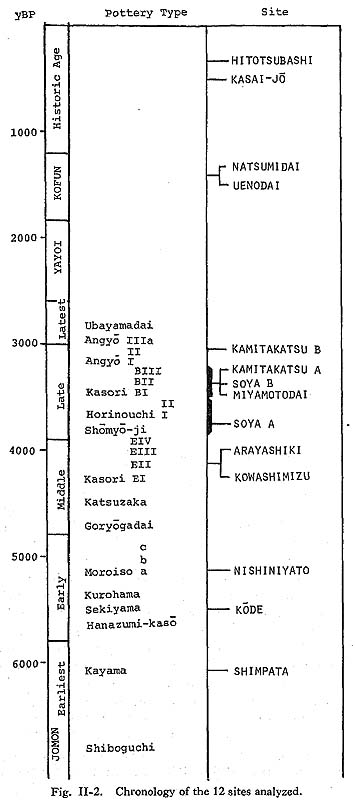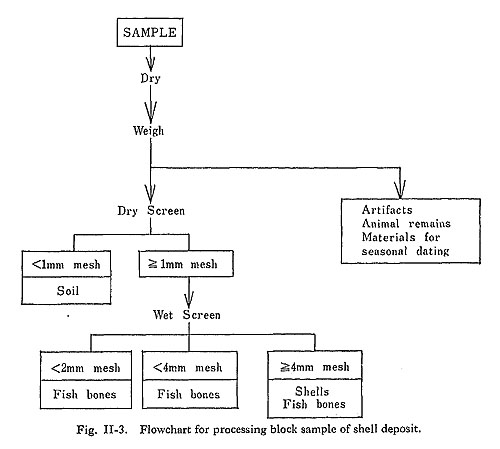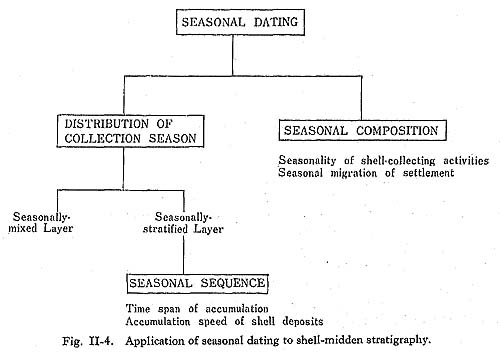PART II. SEASONALITY OF SHELL-COLLECTING
ACTIVITIES IN PREHISTORIC JAPAN
II Materials and Methods
|
The specimens used for the seasonal dating analysis were collected from 12 sites in the South Kanto area (Fig. II-1), the chronology of which is shown in Fig. II-2. The data is based on C-14 dates reviewed by Watanabe (1969) and Suzuki (1973), and also on historical records relevant to the Kofun and Edo periods. The location, geographical situation, scope, and chronology of the sites and outlines of the excavations where analyzed samples were collected are described in Chapter III. Descriptions of the analytical results are given for each shell deposit. General observations concerning the stratigraphy of the shell layers are briefly given in the description of each shell deposit. Further descriptions of the sedimentary facies of the shell deposits, the concentration and preservation of shells, the animal remains and artifacts are found in the reports of the excavations.
Two different methods of sampling were employed. One is the block sampling method, and the other is three-dimensional excavation method. A block sample unit is usually 20 cm by 20 cm square. The thickness of a block is usually 5 cm, although it is occasionally subdivided into two or more strata in cases where the bedding planes of the shell layers are seen within a block. All the artifacts and animal remains within a block were taken together with the soil and brought to the laboratory. Block samples are processed according to a flow chart as illustrated in Fig. II-3. A block sample is dried in its natural condition and its total dry-weight is measured. Before screening, important artifacts and animal bone fragments plus shell specimens for the seasonal analysis are picked out, thus avoiding any damage during the screening process. A 1-mm mesh sieve is used first in order to obtain the soil sample. The remaining materials on the mesh are processed by wet-screening using 1 mm, 2 mm, and 4 mm sieves. Remains in each mesh are dried again and weighed. The concentra-tion of shells in a block (the ratio of the dry weight of shells to the total dry weight), the composition of shell assemblage, and chemical analysis of the pH and Phosphate contents are also examined, and the results are noted in the reports of the excavations.
For the seasonal dating analysis, 5 or 10 clams which were unbroken and well preserved were selected from each block. The methods for the observation of the growth lines and the counting of growth lines were described in a previous chapter. Collected seasons represented are expressed by the number of days from the annual growth minimum or by 8 seasons of one year: early spring (0-45 days from the annual growth minimum), late spring (46-90 days), early summer (91-135 days), late summer (136-180 days), early autumn (181-225 days), late autumn (226-270 days), early winter (271-315 days), and late winter (316-365 days). The results of the seasonal dating analysis are described in the following order (Fig. II-4). The first step in seasonal analysis of shell-midden stratigraphy is the examination of seasonal composition: the frequency distribution of clams collected in each of 8 seasons. Based on the results of this examination, a general pattern of seasonality in shell-collecting activity will be assumed, and migration or permanent settlement of prehistoric people will be discussed.
Secondly, a distribution of seasonally-dated clams in the deposit is available to dis-criminate the seasonally-stratified deposit from seasonally-mixed deposits. When shells collected during several seasons are mixed homogeneously throughout a layer, the deposit has possibly been reworked after deposition. When a cluster of clams collected in a particular season is found in the shell layer, it is considered to be partly a primary deposit. In addition, the seasonal stratification indicates a more exact inclination and orientation of the deposits. The third step is a seasonal sequence. When the season of each stratum changes successively with the calendar, it is possible to estimate the duration of accumulation. |



